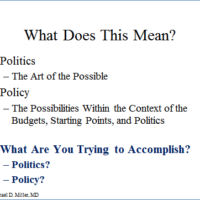I get lots of emails. Some are interesting. Others are Spam – such as the one offering to double my gas mileage by showing me how to run my car on water. (Don’t they know that cars run on air not water!!!!!)
And last week I got one promising to cut health care expenses by 30%. Not just my health care expenses, but the entire countries spending on health care. (See their promotional coupon below.)
As you can see, this is really a call for people to support a public plan as part of health reform. This is a great message and marketing gimmick, but the problem is that nobody has agreed on the definition of a “public health insurance option.” For example, Nancy-Ann Deparle, (Director of the White House Office of Health Reform), has said that a public plan could be like the Federal Employees Health Benefits Plan, which offers government employees a range of private insurance and managed care options. But I haven’t heard anyone suggest that the FEHBP has reduced costs or premiums by 30%.
The 30% figure probably came from the Lewin Group’s analysis of how many people might go into a public plan option and how much it could save. Their report put some numbers around the obvious conclusions that the lower the prices the government plan paid for healthcare products and services, the less it would cost and the number of people going into such a plan would be greater. They specifically found that, “If Medicare payment levels are used in the public plan, premiums would be UP TO 30 percent less than premiums for comparable private coverage. [emphasis added.]
Another factor that could influence the structure of a public plan, (if one is created in this thing we’re calling health reform), is that paying for healthcare care based upon each service, (a.k.a. fee-for-service), is being widely blamed as a prime cause for healthcare inflation. And many payers – including the state of Massachusetts – are looking for other ways to pay for healthcare, such as making payments based upon quality or complete episodes of care….basically anything but fee-for-service (FFS). Thus, the long term viability and cost savings of a public plan based upon Medicare-like FFS reimbursements is questionable. However, creating a public plan based on payment systems that aren’t yet widely used – such as global payments – also seems problematic. And going the route of Massachusetts, (whose Connector is very much like FEHBP), seems too simple and probably won’t produce significant near term savings.
All this leaves me wondering what will happen, and if there are fourth, fifth, or sixth options?



[…] is a Public Plan, and Why? As I’ve written in the past, there has been many descriptions of what a public plan could be – ranging from the Federal […]
IBlogWestHartford – Thanks for the interesting update about the legislation in Connecticut. I’m always glad to hear from my friends in CT and W.Htfd… Keep plugging away!
[…] Miller of the Health Policy and Communications Blog posts about an e-mail campaign using a 30%-off “coupon” to promote a public plan option […]
Fortunately, we need not search far for a model reform plan with a REAL public option – built around expansion of a state employee insurance pool.
In Connecticut, where we have more than 325,000 uninsured, HB6600, or “SustiNet,” just got a favorable report from its second legislative committee and is gaining momentum.
SustiNet ensures that the state wisely uses the dollars it is already spending on state employees, HUSKY (for low-income children) and SAGA by uniting them into a large self-insured health plan.
SustiNet (which is Latin for “sustains” and is taken from our state motto) uses this critical mass of insured residents to improve the health care delivery system (with cost savings) and to phase in the enrollment of more residents of Connecticut, including: the uninsured; people with unaffordable or inadequate insurance; sole proprietors and other self-employed people; small businesses, municipalities, and non-profit employers; and, finally, businesses of any size.
By a “real” public option, I mean that EVERYONE in the state will have quality, affordable health care. If they are employed and their employer isn’t offering insurance that gets them that care, then they ALWAYS have an effective public alternative.
SustiNet was developed with extensive input from all health care stakeholders and with the expertise of Stan Dorn of the Urban Institute. It has the support of, among others: the Connecticut Realtor’s Association; the AFL-CIO; the Connecticut State Medical Society; the Connecticut Public Health Association; and Small Businesses for Health Care Reform.
For more information about the bill, you can go to: http://www.healthcare4every1.org/sustinet